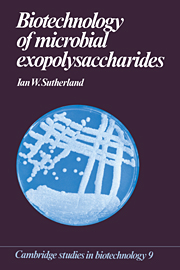Book contents
- Frontmatter
- Contents
- Preface
- 1 Introduction and definition
- 2 Polysaccharide analysis and structural determination
- 3 Exopolysaccharide structure
- 4 Enzymes degrading exopolysaccharides
- 5 Biosynthesis
- 6 Physiology and industrial production
- 7 Genetics, control and regulation of exopolysaccharide synthesis
- 8 Physical properties of exopolysaccharides
- 9 Food usage of exopolysaccharides
- 10 Industrial uses of microbial polysaccharides
- 11 Medical applications of exopolysaccharides
- 12 The future for microbial exopolysaccharides
- References
- Index
4 - Enzymes degrading exopolysaccharides
Published online by Cambridge University Press: 09 September 2009
- Frontmatter
- Contents
- Preface
- 1 Introduction and definition
- 2 Polysaccharide analysis and structural determination
- 3 Exopolysaccharide structure
- 4 Enzymes degrading exopolysaccharides
- 5 Biosynthesis
- 6 Physiology and industrial production
- 7 Genetics, control and regulation of exopolysaccharide synthesis
- 8 Physical properties of exopolysaccharides
- 9 Food usage of exopolysaccharides
- 10 Industrial uses of microbial polysaccharides
- 11 Medical applications of exopolysaccharides
- 12 The future for microbial exopolysaccharides
- References
- Index
Summary
Introduction
While microbial exopolysaccharides, in common with similar polymers from other sources, are the substrates for degradative enzymes, the number of polysaccharases that have been isolated and characterised is relatively small. Only a small number of the polysaccharide-producing microbial species also yield enzymes degrading the same polymers. The exceptions include some of the bacterial species synthesising alginate and hyaluronic acid. A rich source of enzymes degrading bacterial exopolysaccharides has proved to be bacteriophages. These viral particles contain polysaccharases as part of the particle structure, usually in the form of small spikes attached to the base-plate of the phage. After phage infection, the bacterial lysates normally contain further amounts of the same enzyme in soluble form. The advantage of bacteriophages as sources of enzymes degrading polysaccharides is their freedom from other associated glycosidases, which might further degrade any oligosaccharide products. On the other hand, yields of phage-induced enzymes are low and they can only be regarded as laboratory tools of value in structural studies, unless the genes for the enzymes can be cloned and expressed on a large scale in microbial hosts. In addition, not all bacteriophages for exopolysaccharide-producing bacteria yield such enzymes.
There are very few commercially available enzymes acting on microbial polysaccharides. Consequently, the laboratory interested in using enzymes for structural determinations or for quality control must normally isolate its own enzymes. A number of polysaccharases have been obtained from bacterial and fungal sources by using enrichment procedures, with the polysaccharides as substrates.
- Type
- Chapter
- Information
- Biotechnology of Microbial Exopolysaccharides , pp. 38 - 53Publisher: Cambridge University PressPrint publication year: 1990



